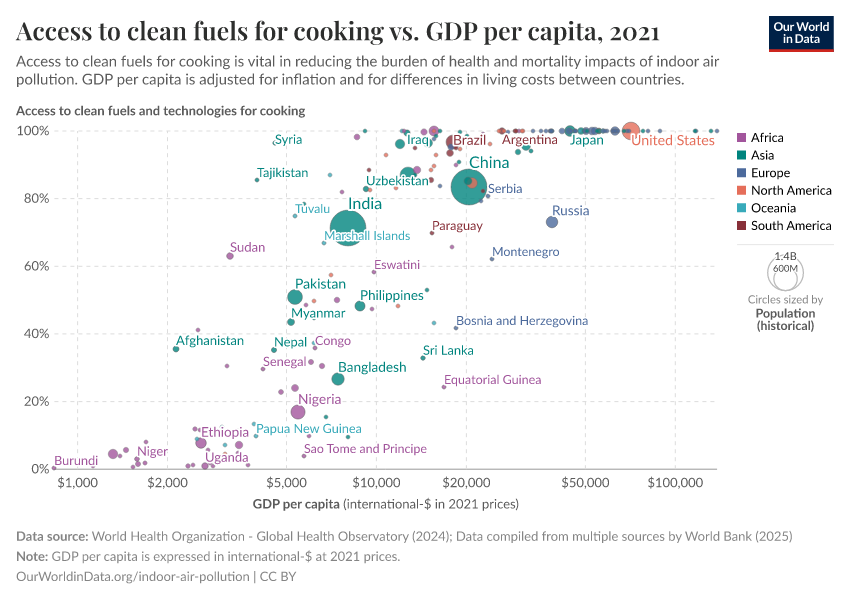The ‘Energy Ladder’: What energy sources do people on different incomes rely on?
3-in-10 people in the world do not have access to clean cooking fuels. What do they use instead?
Rich people use electricity or gas to cook. But 30% of the world do not have access to these clean, modern energy sources. What do they rely on instead?
The visualization below is the World Health Organization's answer. The so-called ‘Energy Ladder’ shows the dominant sources of household energy at different levels of income. From very low incomes on the left, to high incomes on the right.
The poorest households burn wood and other biomass, like crop waste and dried dung. Those who can afford it cook and heat with charcoal or coal.1
These fuels – from crop waste and dung on the left, to charcoal and coal in the middle of the visualization, are termed ‘solid fuels’. The other fuels, on the higher steps of the energy ladder, are termed ‘clean fuels’. When we track the share of households using clean fuels for cooking – an important metric in energy access – this is the definition of clean fuels that is used.
Why is access to clean fuels so important?
Burning solid fuels on open fires or simple stoves fills the room with smoke and toxic chemicals. These traditional energy sources expose those in the household – often women and children – to pollution levels that are far higher than in even the most polluted cities in the world. This indoor air pollution leads to millions of deaths every year. See our entry on Indoor Air Pollution for more information.
Empirical evidence: global cross-country data on access to clean fuels
What is the empirical evidence for the relationship between income and energy source described by the ‘Energy Ladder’?
There are studies that look at this relationship on the household level.2
But even across countries the data shows how strongly access to clean cooking fuels differs between poor and rich countries.
The latest data on the relationship between a country’s average income and the access to clean fuels is shown in the scatterplot.
In most countries in which the average income is lower than $10,000 less than half of the population has access to clean energy. By switching this chart to show the change over time – either by adjusting the time slider or by clicking here – you see that the share who has access to clean energy tends to increase strongly as incomes grow.

Endnotes
WHO (2018) – Fact Sheet - Household air pollution and health
Junfeng (Jim) Zhang, Kirk R Smith (2003) – Indoor air pollution: a global health concern, British Medical Bulletin, Volume 68, Issue 1, December 2003, Pages 209–225, https://doi.org/10.1093/bmb/ldg029
The pollutants encompass a wide range of different compounds, the most important ones being fine particulate matter (PM2.5), black carbon, and carbon monoxide.
WHO 2006) reports: “Burning solid fuels produces extremely high levels of indoor air pollution: typical 24-hour levels of PM10 in biomass-using homes in Africa, Asia or Latin America range from 300 to 3000 micrograms per cubic metre (µg/m3). Peaks during cooking may be as high as 10 000 µg/m3. By comparison, the United States Environmental Protection Agency has set the standard for annual mean PM10 levels in outdoor air at 50 µg/m3; the annual mean PM10 limit agreed by the European Union is 40 µg/m3.” –– WHO (2006) – Fuel for life: household energy and health. Online here.
Delhi is one of the cities with the worst air quality in recent years. Wikipedia has an overview of measurements on their site Air pollution in Delhi and daily data on the air quality in Delhi can be found here.
For a comparison of indoor air pollution levels from different energy sources see Shupler, M., Hystad, P., Birch, A., Miller-Lionberg, D., Jeronimo, M., Arku, R. E., Chu, Y. L., Mushtaha, M., Heenan, L., Rangarajan, S., Seron, P., Lanas, F., Cazor, F., Lopez-Jaramillo, P., Camacho, P. A., Perez, M., Yeates, K., West, N., Ncube, T., … Brauer, M. (2020) – Household and personal air pollution exposure measurements from 120 communities in eight countries: Results from the PURE-AIR study. In The Lancet Planetary Health, 4(10), e451–e462. https://doi.org/10.1016/S2542-5196(20)30197-2
See Shupler, M., Hystad, P., Birch, A., Miller-Lionberg, D., Jeronimo, M., Arku, R. E., Chu, Y. L., Mushtaha, M., Heenan, L., Rangarajan, S., Seron, P., Lanas, F., Cazor, F., Lopez-Jaramillo, P., Camacho, P. A., Perez, M., Yeates, K., West, N., Ncube, T., … Brauer, M. (2020) – Household and personal air pollution exposure measurements from 120 communities in eight countries: Results from the PURE-AIR study. In The Lancet Planetary Health, 4(10), e451–e462. https://doi.org/10.1016/S2542-5196(20)30197-2
Cite this work
Our articles and data visualizations rely on work from many different people and organizations. When citing this article, please also cite the underlying data sources. This article can be cited as:
Max Roser (2021) - “The ‘Energy Ladder’: What energy sources do people on different incomes rely on?” Published online at OurWorldinData.org. Retrieved from: 'https://archive.ourworldindata.org/20251220-152415/energy-ladder.html' [Online Resource] (archived on December 20, 2025).BibTeX citation
@article{owid-energy-ladder,
author = {Max Roser},
title = {The ‘Energy Ladder’: What energy sources do people on different incomes rely on?},
journal = {Our World in Data},
year = {2021},
note = {https://archive.ourworldindata.org/20251220-152415/energy-ladder.html}
}Reuse this work freely
All visualizations, data, and code produced by Our World in Data are completely open access under the Creative Commons BY license. You have the permission to use, distribute, and reproduce these in any medium, provided the source and authors are credited.
The data produced by third parties and made available by Our World in Data is subject to the license terms from the original third-party authors. We will always indicate the original source of the data in our documentation, so you should always check the license of any such third-party data before use and redistribution.
All of our charts can be embedded in any site.